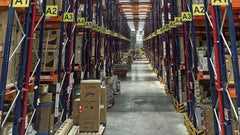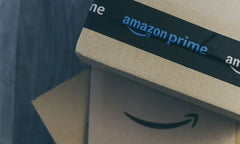
U.S. Online Sales Surge on Amazon Prime Day: What It Means for Retail
Table of Contents
- Key Highlights:
- Introduction
- The Rise of Prime Day: A New Retail Tradition
- Competitive Reactions from Retail Giants
- Consumer Behavior and Spending Trends
- Economic Factors Impacting Retail
- Looking Ahead: The Future of Retail Sales Events
- The Role of Technology in Shaping Consumer Experiences
- Sustainability and Ethical Considerations in E-Commerce
- FAQ
Key Highlights:
- U.S. online sales soared by 9.9% year-over-year, totaling $7.9 billion on the first day of Amazon's Prime Day, marking the highest e-commerce day of 2023.
- Competing retailers like Walmart, Target, and Best Buy launched their own sales events to capitalize on the Prime Day frenzy.
- Despite initial soft demand in certain categories, analysts anticipate a significant uptick in overall online spending throughout the extended Prime Day event.
Introduction
Amazon's Prime Day has evolved into a pivotal moment in the retail calendar, not just for the e-commerce giant but for the entire industry. This year, the sale commenced with a remarkable $7.9 billion in online sales, reflecting a 9.9% year-over-year increase. As the event unfolds over four days, it has sparked a competitive response from other major retailers, creating a shopping landscape that is both dynamic and complex. This article delves into the implications of this year's Prime Day sales, the competitive strategies employed by other retailers, and the broader economic factors influencing consumer spending.
The Rise of Prime Day: A New Retail Tradition
Since its inception in 2015, Prime Day has been a strategic tool for Amazon to attract new subscribers and boost sales during the summer slump. Initially designed to celebrate Amazon's anniversary and reward Prime members, the event has grown into a global phenomenon, driving billions in sales across various sectors. In its first year, Prime Day generated $426 million in sales. Fast forward to 2023, and the event's first day alone eclipsed the total online spending during the previous year's Thanksgiving, which stood at $6.1 billion.
This growth trajectory can be attributed to several factors, including the increasing number of Prime members, enhanced promotional strategies, and the expanding variety of products available for discounts. Amazon's push for exclusivity—offering deals only to Prime members—has also created a sense of urgency and a desire to sign up for the service, further entrenching Amazon's dominance in the e-commerce sector.
Competitive Reactions from Retail Giants
The growing significance of Prime Day has not gone unnoticed by competitors. Retailers like Walmart, Target, and Best Buy have increasingly sought to counter Amazon's influence by launching their own promotional events in tandem with Prime Day. This year's response was particularly aggressive:
- Walmart kicked off a six-day deals event, aiming to capture sales from consumers looking for alternatives to Amazon.
- Target launched its Circle Week, filled with promotions designed to entice shoppers, particularly those who are already loyal customers.
- Best Buy introduced a "Black Friday in July" campaign, slashing prices on electronics and home goods, echoing the themes of urgency and value that Prime Day embodies.
These strategies reflect an industry-wide recognition that Prime Day has become a crucial period for retail sales, compelling even the most established players to adapt quickly to the changing landscape.
Consumer Behavior and Spending Trends
Despite the impressive early sales numbers, experts have noted that demand in certain categories appears softer than in previous years. Kashif Zafar, CEO of Xnurta, an advertising platform serving over 20,000 online businesses, commented on the mixed performance of various product categories. While home and outdoor goods displayed strong demand, categories like beauty and household essentials experienced a decrease in early sales.
Zafar's insights suggest that consumers are taking a more measured approach to their spending this year, possibly in response to economic uncertainties. The four-day duration of Prime Day allows for a different purchasing rhythm, with shoppers spreading out their buying decisions rather than making impulse purchases. This shift is particularly relevant in a climate where economic factors, including inflation and changing consumer confidence, play a significant role in spending behaviors.
Economic Factors Impacting Retail
The current economic climate is significantly influencing consumer sentiment and spending. Reports indicate a deterioration in consumer confidence in June, attributed to ongoing concerns about tariffs and their potential impact on prices. The Conference Board's findings highlight that rising costs due to tariffs have put pressure on consumers, who are now more cautious in their purchasing decisions.
Despite these challenges, Amazon CEO Andy Jassy noted that the company has not seen significant price increases on its platform as a direct result of tariffs. However, some third-party sellers have reported price hikes due to increased costs of goods manufactured in China, indicating that while Amazon may be absorbing some costs, the broader market is still feeling the effects of trade policies.
Looking Ahead: The Future of Retail Sales Events
As Prime Day continues through Friday, predictions indicate that total online sales could reach $23.8 billion across all retailers during the event. This figure is comparable to the combined sales of two Black Fridays, underscoring the event's importance in the retail calendar. The extended duration of Prime Day, now spanning four days, has changed the dynamics of consumer spending, allowing for more strategic purchasing.
With this evolution in mind, retailers will likely continue to innovate and adapt their strategies to capture consumer attention during key sales events. As competition heats up, the ability to understand consumer behavior will be essential for all retail players, not just Amazon.
The Role of Technology in Shaping Consumer Experiences
In addition to traditional sales strategies, technology plays an increasingly significant role in shaping the consumer experience during events like Prime Day. Retailers are leveraging data analytics, artificial intelligence, and personalized marketing to enhance their offerings and boost engagement with shoppers.
For instance, predictive analytics can inform retailers about trending products and consumer preferences, enabling them to tailor their promotions accordingly. Social media advertising and influencer partnerships further amplify reach, allowing retailers to engage potential customers where they are most active. As technology continues to advance, the integration of innovative solutions will likely become a defining factor in the success of future sales events.
Sustainability and Ethical Considerations in E-Commerce
As the e-commerce landscape continues to grow, sustainability and ethical considerations are becoming increasingly important to consumers. Shoppers are now more conscious of their purchases, favoring brands that prioritize sustainability and social responsibility. Retailers are responding by emphasizing eco-friendly products, ethical sourcing, and transparent supply chains.
During Prime Day, these themes are likely to resonate with consumers, influencing purchasing decisions. Retailers that effectively communicate their commitment to sustainability may gain a competitive advantage, appealing to environmentally-conscious shoppers looking to make responsible choices.
FAQ
What is Amazon Prime Day, and why is it significant?
Amazon Prime Day is an annual sales event hosted by Amazon, offering exclusive deals and discounts to Prime members. It has grown to become one of the largest e-commerce events globally, driving significant sales for Amazon and other retailers.
How did U.S. online sales perform during Prime Day this year?
On the first day of Prime Day, U.S. online sales reached $7.9 billion, a 9.9% increase year-over-year, marking it as the highest e-commerce day of 2023.
What strategies are competing retailers using to counter Amazon's Prime Day?
Retailers like Walmart, Target, and Best Buy have launched their own sales events to coincide with Prime Day, offering competitive discounts and promotions to attract consumers.
How are economic factors influencing consumer spending during Prime Day?
Concerns over rising prices due to tariffs and inflation have affected consumer confidence, leading to more cautious spending behavior. Despite this, retailers anticipate strong sales throughout the Prime Day event.
What role does technology play in enhancing the shopping experience during Prime Day?
Retailers are utilizing data analytics, artificial intelligence, and personalized marketing strategies to improve customer engagement and tailor promotions, making the shopping experience more relevant and appealing to consumers.
How can consumers make the most of Prime Day sales?
To maximize savings during Prime Day, consumers should compare prices across different retailers, take advantage of loyalty programs, and be strategic about their purchases, considering both needs and wants carefully.
What trends should we expect in future retail events?
As competition increases, retailers will likely continue to innovate their sales strategies, focusing on technology integration, sustainability, and personalized shopping experiences to attract consumers during future sales events.
E-ticaretinizi haftalık içgörülerimiz ve güncellemelerimizle güçlendirin!
Ticaret dünyasında neler olup bittiğiyle uyumlu kalın
E-posta Adresi
Sizin İçin Seçilmiş

09 July 2025 / Blog
Brand Guardians: Effective Strategies to Combat Cyber Counterfeiting
Daha Fazla Oku

09 July 2025 / Blog


